'Moonlight'
“A portion of the figure was very distinct,” declared the minutes of the meeting, “but owing to the motion of the Moon, the greater part was confused. The time occupied was twenty minutes, and the size of the figure was about one inch in diameter. Daguerre had attempted the same thing but did not succeed. This is the first time that anything like a distinct representation of the moon’s surface has been obtained.” Contemporary Description of John William Draper’s first Moon Photograph of 1840
Early Efforts
The first attempt at photographing an astronomical object was made by Louis Daguerre (1787-1851) in 1839 when he tried to image the Moon, but his efforts were met with failure. The following year, John William Draper (1811-1882), a Professor of Chemistry at New York University obtained the first successful image of the Moon, and in doing so earned himself title of the ‘First Astrophotographer’.
It was not until the 18th of December 1849 that the next photograph of the Moon was obtained by the Boston Daguerreotypist, John Adams Whipple (1822-1891), using the 15 inch ‘Great Refractor’ at Harvard College Observatory.
Two years later in 1851 he took a series of Lunar Daguerreotypes which became prize winning exhibits at the Great Exhibition held that year at the Crystal Palace, London. In the years that followed a number of astronomers including Warren De La Rue (1815-1889), Lewis Morris Rutherfurd (1816-1892) and Henry Draper (1837-1882)took photographs of the Moon of ever increasing quality and in much greater detail.
In 1852, De La Rue takes first wet collodion Images of the Moon with his 13 inch Reflector from his Observatory in Canonbury, Middlesex, which shows its surface in increased detail. Six years later he obtains the the first stereoscopic images of the moon from his new observatory at Cranford, Middlesex.
In 1863, Henry Draper begins taking photographs of the Moon with his 15 inch Reflector constructed by himself. These photographs were at the time the finest ever taken, until the work of Lewis Morris Rutherfurd two years later.
In 1865, the New York amateur scientist, Lewis Morris Rutherfurd, obtains excellent images of the Moon using a specially corrected photographic 11.25-inch (290mm) lens. His images were for many years the best ever taken, until the work of Pickering, Loewy and Puiseux.
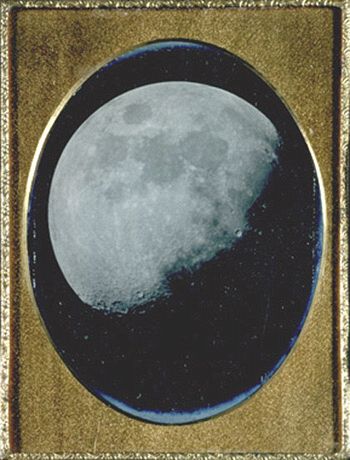
John Adams Whipple, Gibbous Moon, 1852
Better Efforts
During the 1890s and 1900s images of the Moon were taken of sufficiently high quality and detail to form the basis of the earliest Photographic Atlases of the Moon.
In 1897, Edward Singleton Holden begins issuing in serial form the Lick Observatory Atlas of the Moon compiled by Ladislaus Weinek from photographs obtained at the Lick and Paris Observatories. Only 19 sheets of reproduced photographs out of the 60 originally intended were ever published; of low resolution and poor quality.
In 1903 the Harvard astronomer, William Henry Pickering (1858-1939) became the first to publish a complete photographic atlas of the Moon with the appearance of his: ‘The Moon –
A summary of the Existing Knowledge of our Satellite with a Complete Photographic Atlas’. His photographs were taken in an eight month period from 31st December 1900 to 31st August 1901 from Mandeville, Jamaica using a horizontal refractor of 12-inch aperture and 135 feet focal length. Pickering divided his atlas into sixteen areas, with a photographs taken of each area but under five differing illuminations.
Although the photographs he obtained were not of the highest, the fact that the same features were imaged during differing lunar phases was a very useful feature of the atlas. It is well known that lunar feature under differing illumination ‘take on’ very differing aspects and are often difficult to identify without photographic help.
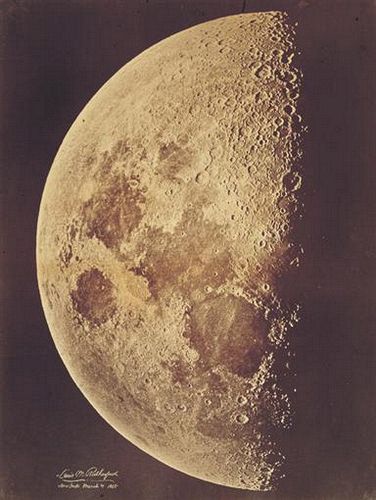
Lewis Morris Ruthefurd, 'First Quarter' Moon, 1865
First 'True' Photographic Atlas
However the first true photographic atlas of the Moon was the work of Moritz Loewy (1833-1907) and Pierre Henri Puiseux (1855-1928) of the Paris Observatory. In 1894 they took the first photograph of the Moon using the Observatory’s 23.6-inch Equatorial Coude Refractor that would be included in their monumental L’Atlas Photographique De La Lune published in 1910.
Their work was published in twelve parts from 1896 to 1910. Each part relates to a specific area of the moon, and contains high quality photographs of the region, as well as a description of the major lunar features, craters, mare, mountain ranges etc present. A general index of features was also published as the thirteenth part of the atlas.
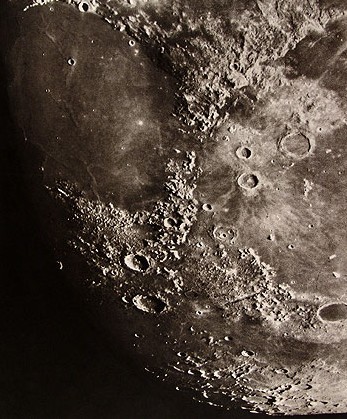
Mare Imbrium, Maurice Loewy & Pierre Henri Puiseux, 1902
LOPAM
The photographs of Loewy and Puiseux were to remain unsurpassed in quality for the next fifty years until those taken by the Lunar Orbiter Probes in the 1960s, although Francis Gladheim Pease came very close with his images of 1919, taken with the 100-inch Hooker Telescope at Mount Wilson. In 1964, the Lunar Orbiter program was initiated, as a series of five unmanned lunar orbiter missions launched by the United States from 1966 through 1967. All five of the Lunar Orbiter missions were successful, and 99 percent of the Moon was mapped from photographs taken with a resolution of 60 metres or better.
The first three missions were dedicated to imaging 20 potential manned lunar landing sites, selected based on Earth-based observations. These were flown at low inclination orbits. The fourth and fifth missions were devoted to broader scientific objectives and were flown in high-altitude polar orbits. Lunar Orbiter 4 photographed the entire nearside and 9 percent% of the far side, and Lunar Orbiter 5 completed the far side coverage and acquired medium (20 m) and high (2 m) resolution images of 36 pre-selected areas.
In 1971 the images obtained from the Lunar Orbiters were used to create LOPAM – the Lunar Orbiter Photographic Atlas of the Moon compiled by David Bowker and J. Kenrick Hughes. This work is now considered to be the definitive reference manual on the global photographic coverage of the Moon.
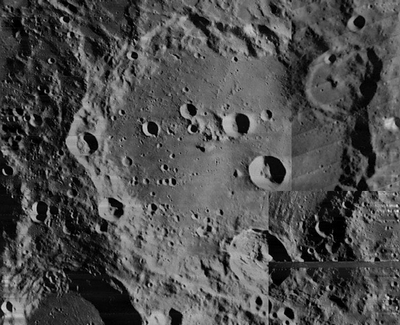
LOPAM Image of the crater Clavius
Quote
“As the image of the Moon photographed with telescopes of the dimensions usually found in the hands of amateurs is small, even if amplifying lenses are used, the chief desideratum is to get a negative of extreme sharpness, which will admit of considerable subsequent enlargement.”
Henry Hayden Waters (1880-1939), from Astronomical Photography for Amateurs, 1921.
To read more go to the eBook on the Lunar Astrophotography or buy the complete eBook 'Catchers of the Light' - A History of Astrophotography.
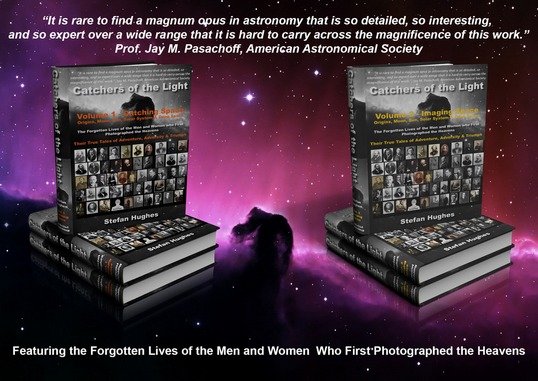
Buy the eBook or Printed Book at the 'Catchers of the Light' shop.